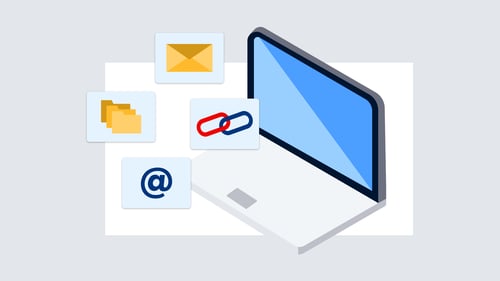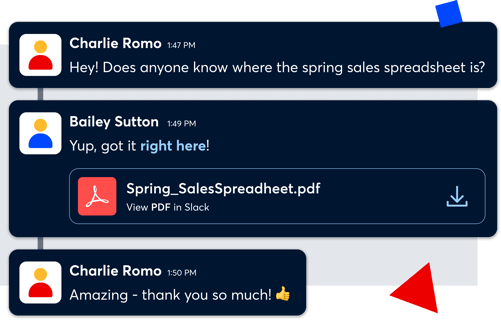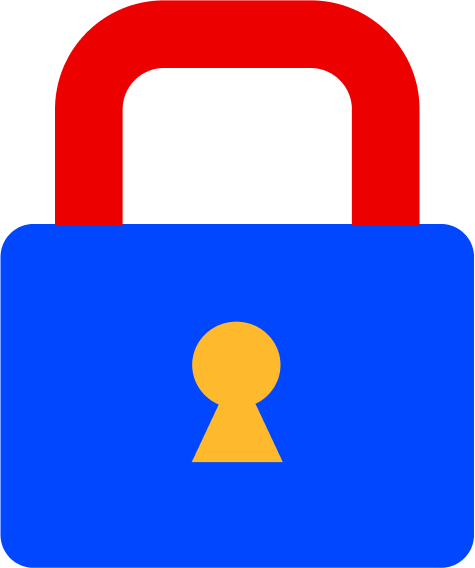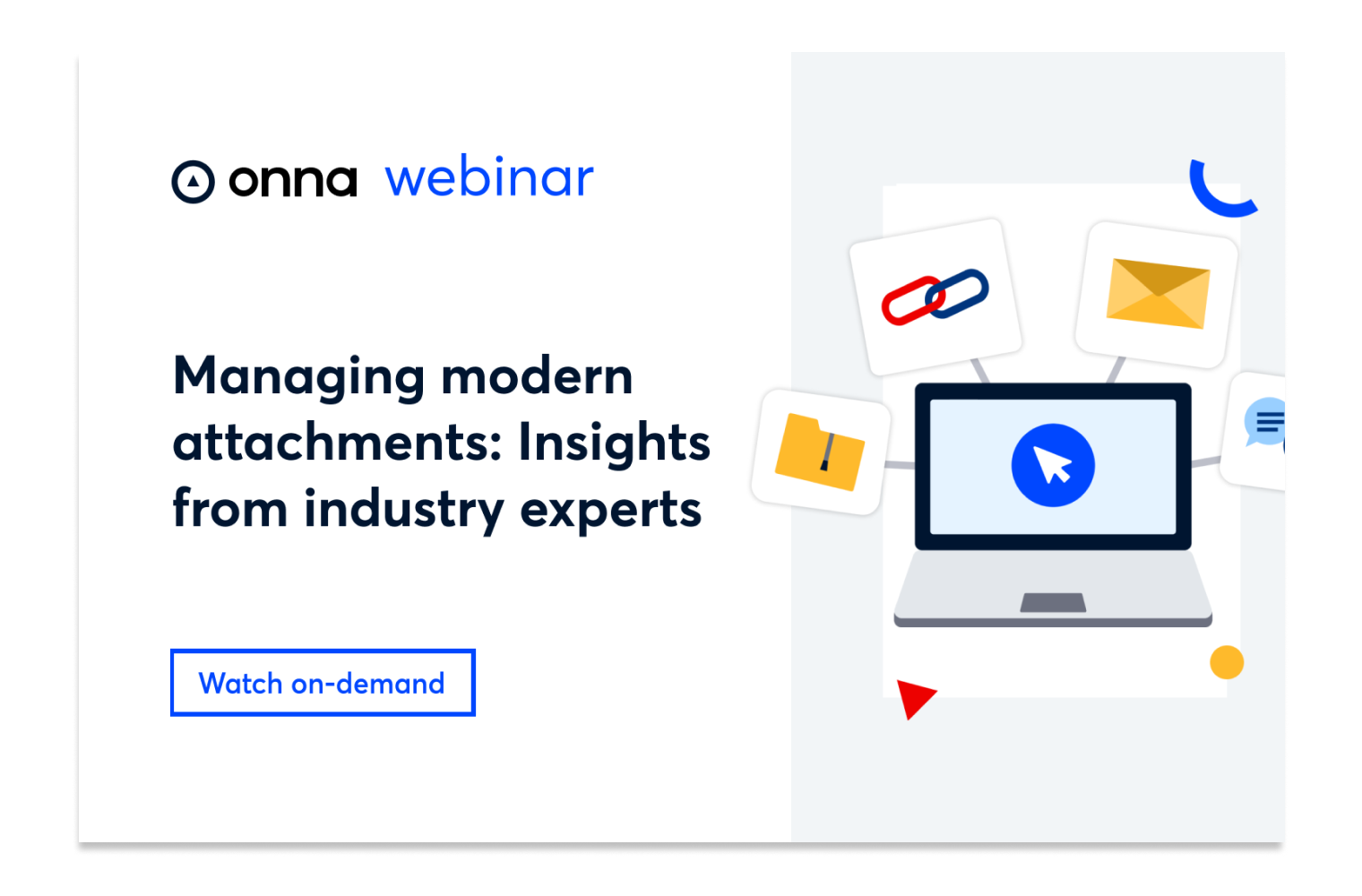Modern attachments and eDiscovery: Navigating the complexities of linked documents

The saying “the early bird gets the worm” emphasizes the importance of starting something early to maximize potential outcomes. In the context of “modern attachments,” legal teams, IT professionals, and eDiscovery practitioners must quickly establish practices to manage them effectively.
Defining modern attachments
Modern attachments, also known as embedded files, are essentially hyperlinks that direct users to related electronic resources or documents. You often find these attachments in collaborative applications or chat platforms, where they act as “pointers” to referenced electronic docs. Some eDiscovery practitioners debate the term “modern attachment” and suggest using “pointer” as a more accurate description.

When you share a linked file in a conversation, it’s usually one-directional, meaning it doesn't affect the original message. The file itself can be a website or an electronic doc that remains static or updates constantly.
Challenges posed by modern attachments
Historically, federal rules required the preservation and production of document families as business records. For instance, when parties produced an email with attachments, they had to maintain the “family” and deliver the files accordingly. However, linked files in modern communication and collaboration workflows present challenges, as users can modify, delete, or update these files over time. Google Docs serves as a common example, allowing multiple users to edit a document simultaneously and invite others to make changes as well.
Key concerns for linked files include determining the appropriate level of preservation or collection, deciding if organizations should keep “as sent” versions of referenced content, and figuring out how to store these files. As a result, it’s necessary to develop guidelines that address these issues.
In the 2021 New York case Nichols v Noom, the judge emphasized the distinction between traditional and modern attachments, siding with the defendants who argued that producing hyperlinked documents would be overly burdensome and disproportionate. This decision raised concerns about not requiring the production of hyperlinked documents.
Federal Rule 34 of the Federal Rules of Civil Procedure states that parties must produce requested documents in discovery in a “reasonably usable form.” By not providing linked documents, a party may not fully disclose available information or may limit the information given to the other party. Legal scholars have continued to debate the proper handling of modern attachments in litigation workflows since the Noom case.
Tackling modern attachments in early discovery discussions
The Noom case underscores the importance of actively addressing linked files during early discovery discussions under Rule 26(f). In that case, parties neglected to include language about linked files in their ESI agreement, which led to complications later on. ESI agreements enable parties to discuss, plan, and identify practical solutions for managing electronically stored information.
As court opinions increasingly tackle modern attachment issues, parties now incorporate modern attachment descriptions in ESI orders for many litigation matters. For example, in IN RE: Acetaminophen – ASD-ADHD Products Liability Litigation, specific language covers the collection of embedded files (aka modern attachments). This proactive approach helps both parties understand requirements and expectations during discovery and enables eDiscovery teams to preserve, collect, and retain modern attachments — or at least attempt to — without creating an overly burdensome task.
Gauging the severity of the issue requires identifying the sources of modern attachments. For instance, organizations using Slack and Google Docs might share files through hyperlinks in Slack messages. If multiple channels link to the same doc and the link becomes unavailable during preservation or collection, the party may only have the latest version, if any.
A similar problem can emerge when an email includes a hyperlinked file. When producing the captured email for the opposing party, the link might no longer be accessible, making tracking and retrieval difficult and time-consuming. Organizations must establish open and early communication to understand the implications of modern attachments in collaboration and communication apps. Actively including modern attachments in ESI agreements can help prevent future issues and foster a more efficient discovery process.
The role of technology in collecting modern attachments
Technology plays a vital role in collecting hyperlinked documents, and various tools can aid in the process when set up correctly. Instead of outright rejecting linked files, it’s worth considering technologies that provide secure preservation and collection methods.
In-house IT, legal teams, and outside counsel must address the challenges posed by modern attachments. Effectively managing these tools, establishing standard protocols, or preparing negotiation strategies when necessary is essential. Handling modern attachments requires a case-by-case approach for discovery, and discussing options early can help avoid confusion and potential problems down the road.
Although organizations typically don’t want to keep or over-collect information, there are times when having linked documents readily available — within any retention period — can provide the crucial evidence needed to win a case.
Put simply, the importance of proactively managing modern attachments cannot be overstated. By developing standard protocols, fostering early conversations, and creating tailored solutions, organizations can stay ahead of the curve and safeguard their legal interests.
Ready to learn more? Dive deeper into the topic of modern attachments by watching our on-demand webinar here.
 eDiscovery
eDiscovery Collections
Collections Processing
Processing Early Case Assessment
Early Case Assessment Information Governance
Information Governance Data Migration
Data Migration Data Archiving
Data Archiving Platform Services
Platform Services Connectors
Connectors Platform API
Platform API Pricing Plans
Pricing Plans Professional Services
Professional Services Technical Support
Technical Support Partnerships
Partnerships About us
About us Careers
Careers Newsroom
Newsroom Reveal
Reveal Logikcull by Reveal
Logikcull by Reveal Events
Events Webinars
Webinars OnnAcademy
OnnAcademy Blog
Blog Content Library
Content Library Trust Center
Trust Center Developer Hub
Developer Hub
